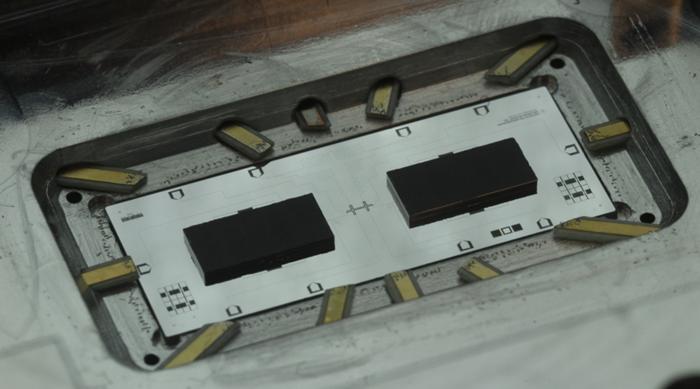
Entanglement is an intriguing phenomenon in quantum physics, fundamental to understanding the interconnectedness of particles across distances. While many experiments have successfully demonstrated this effect using subatomic particles, recent advancements are taking this concept and applying it on a grander scale. Researchers at the University of Chicago have pushed the boundaries of quantum science by demonstrating high-fidelity entanglement between two mechanical resonators, showcasing the potential of entangling larger, macroscopic objects. This groundbreaking work opens new avenues in the rapidly evolving landscape of quantum information technology.
Professor Andrew Cleland’s lab at the UChicago Pritzker School of Molecular Engineering is at the forefront of this innovative research. Their recent findings, published in Nature Communications, present a significant leap towards building more complex quantum systems. By focusing on acoustic wave resonators, the research team has established a method for entangling two physically separate resonators, which serve as the basis for future quantum computing architectures. Unlike traditional experiments that often rely on electrons and photons, this study emphasizes the entanglement potential of larger entities, hinting at a new dimension of quantum mechanics.
Entanglement occurs when two or more particles become correlated in such a way that the state of one instantly influences the state of the other, regardless of the distance separating them. The researchers focused on phonons—quanta of vibrational energy that encompass the collective motions of particles—rather than manipulating individual atoms or electrons. Phonons, often described as quantum particles of sound, provide an expansive arena for realizing quantum entanglement on a more substantial scale. This research not only bridges the gap between quantum and classical physics but also suggests a novel pathway to create entangled states that could be harnessed for advanced quantum computing applications.
The significance of successfully entangling mechanical resonators lies in their larger scale, potentially usable in applications beyond fundamental physics. The ability to entangle massive objects indicates that the quantum regime may extend further than previously understood. The implications for quantum processors, which require intricate entangled states for efficient operation, are substantial. The proposed system could essentially function as a ‘unit cell’ for a quantum processor, paving the way for more extensive and sophisticated quantum networks.
Generating and detecting phonon states involves intricate mechanisms involving superconducting qubits, a crucial aspect of the experiment. Each resonator is mounted on its own chip, where these qubits facilitate the entanglement process. Remarkably, the team has not only confirmed the existence of entanglement but has also demonstrated that these resonators can achieve high fidelity in their entangled states. Past experiments have faced challenges with limited fidelity, but this research indicates a promising future for enhanced performance and reliability.
Furthermore, the study brings to light the nature of macroscopic entanglement, a topic often softened by classical interpretations of physics. The researchers argue that their successes challenge traditional views where quantum mechanics primarily governs the subatomic realm and classical physics dictates the observable world, bridging two realms that were once thought to remain separate. This ability to manipulate larger systems brings Erwin Schrödinger’s famous metaphor of a cat existing in a superposition state into the tangible world of quantum physics, creating a conceptual framework for the examination of exotic states of matter at larger scales.
Looking ahead, the next challenge encountered by the research team involves optimizing the lifetime of the mechanical resonators. Enhancing the time that the resonators maintain their quantum state (quantum coherence) would allow extended entanglement duration, empowering more sophisticated communication protocols and distributed quantum computing capabilities across networks. Current limitations present a barrier; however, researchers remain optimistic about potential strategies to significantly increase resonator lifetimes, from approximately 300 nanoseconds to over 100 microseconds.
There is a sense of urgency and excitement surrounding future experiments that could incorporate various geometrical configurations or methodologies within quantum acoustics to realize these long-lasting states. Such developments could vastly improve existing frameworks for quantum communication. With a longer entangled state, researchers could explore complicated quantum operations, potentially encoding logical operations into these phononic states for enhanced computational power. The theoretical underpinnings from Cleland’s research can facilitate the transition of macroscopic systems from mere demonstrations of quantum phenomena to practical applications in emerging quantum technological frameworks.
This work not only speaks to the capabilities of a dedicated research team but could also act as a catalyst for interdisciplinary collaboration across quantum physics and engineering. As the fields converge, advancements like this stoke interest in discovering ways to practically implement quantum systems that surpass the boundaries set by current technologies. The vision of an interconnected quantum network driven by entangled states might be closer than anticipated, reshaping what we understand about information transfer and computational power.
To summarize, this pioneering research from UChicago’s Cleland Lab signifies a leap towards a sophisticated understanding of quantum entanglement that transcends traditional particle physics. With applications stemming from enhanced quantum processors to intricate networks, exploring the larger scale of quantum entanglement promises a wealth of opportunities. It emphasizes the importance of collaboration between various disciplines to fuel the next wave of technological advancement driven by quantum mechanics.
As quantum mechanics redefines our technological capabilities, the ongoing research from the University of Chicago not only enriches our understanding but also moves us towards potential applications that could one day transform industries. Harnessing the seemingly abstract principles of quantum physics into practical, high-performance applications embodies the spirit of innovation driving modern science and technology forward.
Subject of Research: Multi-phonon entanglement in mechanical resonators
Article Title: Deterministic multi-phonon entanglement between two mechanical resonators on separate substrates
News Publication Date: February 7, 2025
Web References: UChicago PME, Nature Communications
References: Chou et al, Nature Communications, DOI: 10.1038/s41467-025-56454-0
Image Credits: Photo courtesy of Cleland Lab
Keywords
Quantum entanglement, phonons, mechanical resonators, quantum mechanics, superconducting qubits, quantum computing, acoustic wave resonators.
Tags: acoustic wave resonatorsadvancements in quantum information technologybuilding complex quantum systemsexploring the quantum realmfuture of quantum computing architecturesinterconnectedness of quantum particlesmacroscopic entanglement in quantum mechanicsmechanical resonators in quantum physicsNature Communications quantum findingsProfessor Andrew Cleland’s researchquantum entanglement applicationsUniversity of Chicago quantum research





